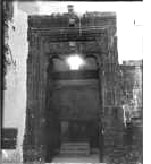Deir Mar Bihnam is located near the village of Khathar Elias 32km southeast of Mosul in northern Iraq, about 6km from the ancient Assyrian city of Nimrud (Calah). It is situated between the Tigris river and the upper Zab river. It is also known as Deir Al-Jubb (The Cistern Monastery).
It is under the care of the Syriac Catholic Church (previously Syriac Orthodox Church)
It is a fortress-like structure, rising adjacent to the tomb of Mar Behnan.
Deir Mar Behman houses one of the most valuable Syriac libraries in existence today.
There are two main theories as to the establishment of the monastery. One states that the monastery is believed to have been built during the 4th century and belonged to the Deir Mar Mattai. The other theory is that the monastery is named after the martyr Fihnam (not Bihnam), an Assyrian who was killed in the late 4th century.
The monastery’s walls have doors carved with ancient Assyrian designs and many detailed carvings in Syriac, Arabic, and Armenian dating to the early 12th century.
Sculptures in the church show that renovations were done in 1164, 1250-1261 AD. Records show that the monastery suffered greatly during the period from 1743 - 1790 which saw attacks by the Kurdish leaser Nadir Shah attacks.
In 1790 Deir Mar Behnam was taken over by the Catholic Church and was managed for 8 years until the Syriac Orthodox church took it back. For some unknown reason, the monks abandoned the monastery in 1819. The monastery changed hands again to the Syriac Catholic Church in 1839.
source: www.chaldeansonline.net/iraq/syriac.htm



